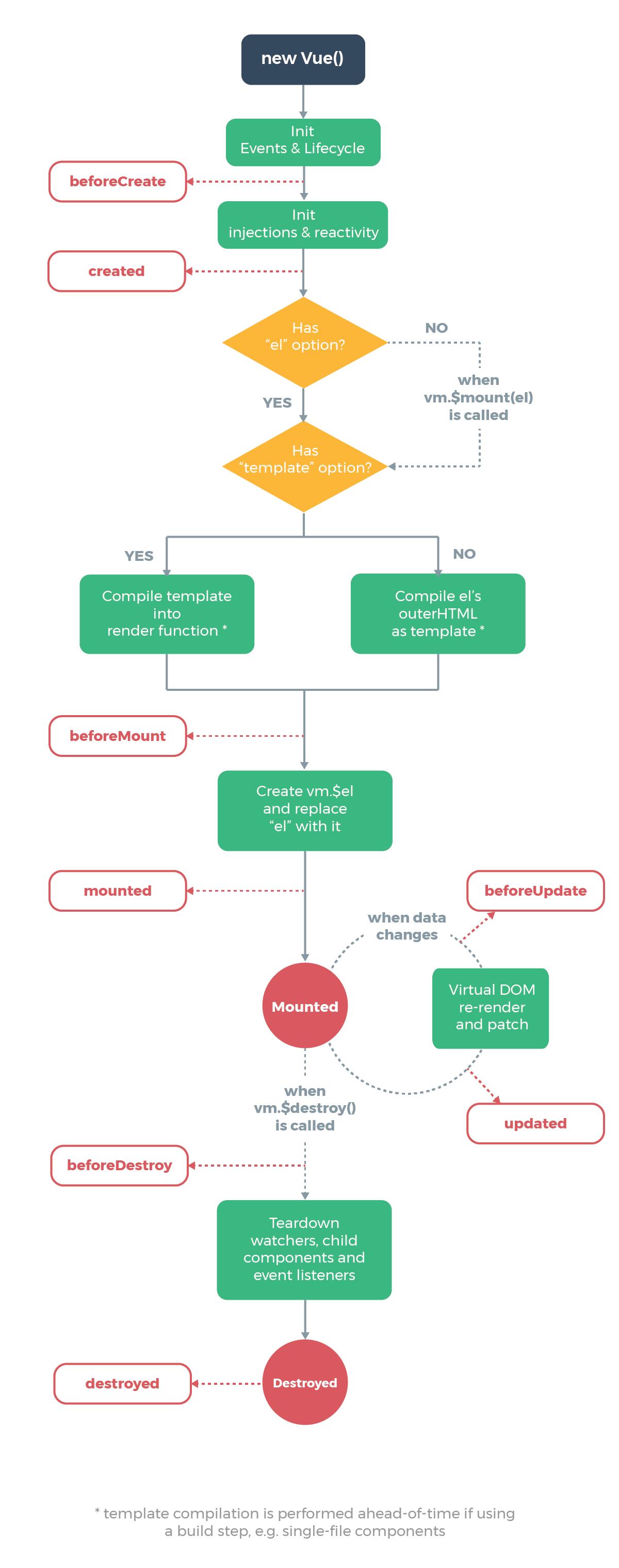Vue——Vue初始化
Posted 。思索
tags:
篇首语:本文由小常识网(cha138.com)小编为大家整理,主要介绍了Vue——Vue初始化相关的知识,希望对你有一定的参考价值。
前言
今天我们来解密下init.ts中的代码内容,并结合 vue 生命周期来分析下 vue 的初始化;
内容

init.ts
import config from \'../config\'
import initProxy from \'./proxy\'
import initState from \'./state\'
import initRender from \'./render\'
import initEvents from \'./events\'
import mark, measure from \'../util/perf\'
import initLifecycle, callHook from \'./lifecycle\'
import initProvide, initInjections from \'./inject\'
import extend, mergeOptions, formatComponentName from \'../util/index\'
import type Component from \'types/component\'
import type InternalComponentOptions from \'types/options\'
import EffectScope from \'v3/reactivity/effectScope\'
// vue 实例id
let uid = 0
export function initMixin(Vue: typeof Component)
// 接收实例化传入的参数
Vue.prototype._init = function (options?: Record<string, any>)
//vue 实例
const vm: Component = this
// 每个vue实例都有对应的一个实例id
vm._uid = uid++
let startTag, endTag
/* istanbul ignore if */
// 代码覆盖率测试
if (__DEV__ && config.performance && mark)
startTag = `vue-perf-start:$vm._uid`
endTag = `vue-perf-end:$vm._uid`
mark(startTag)
// a flag to mark this as a Vue instance without having to do instanceof
// check
// 标记作为vue的实例不必去执行instanceof
vm._isVue = true
// avoid instances from being observed
// 避免实例被observed观察
vm.__v_skip = true
// effect scope
// 影响范围
vm._scope = new EffectScope(true /* detached */)
vm._scope._vm = true
// merge options
// 合并参数
// 判断是否是子组件
if (options && options._isComponent)
// optimize internal component instantiation
// 优化内部组件实例化
// since dynamic options merging is pretty slow, and none of the
// internal component options needs special treatment.
// 由于动态选项合并非常缓慢,并且没有一个内部组件选项需要特殊处理。
// 传入vue实例并进行组件初始化
initInternalComponent(vm, options as any)
else
// 根组件配置 | 合并参数
vm.$options = mergeOptions(
// 解析构造函数参数
resolveConstructorOptions(vm.constructor as any),
options || ,
vm
)
/* istanbul ignore else */
// 代码覆盖测试
if (__DEV__)
initProxy(vm)
else
vm._renderProxy = vm
// expose real self
vm._self = vm
// 核心的核心
// 初始化生命周期
initLifecycle(vm)
// 初始化事件监听
initEvents(vm)
// 初始化渲染
initRender(vm)
// 调用生命周期的钩子函数 | beforeCreate
callHook(vm, \'beforeCreate\', undefined, false /* setContext */)
// https://v2.cn.vuejs.org/v2/api/#provide-inject
// 在data/props前进行inject
initInjections(vm) // resolve injections before data/props
initState(vm)
// https://v2.cn.vuejs.org/v2/api/#provide-inject
// provide 父组件提供的数据
// inject 子组件进行注入后直接使用
// 在data/props后进行provide
initProvide(vm) // resolve provide after data/props
// 调用生命周期钩子函数 | created
callHook(vm, \'created\')
/* istanbul ignore if */
// 代码覆盖测试
if (__DEV__ && config.performance && mark)
vm._name = formatComponentName(vm, false)
mark(endTag)
measure(`vue $vm._name init`, startTag, endTag)
// 组件如果设置了el则挂载到指定的el上
if (vm.$options.el)
vm.$mount(vm.$options.el)
/**
* 初始化内部组件
*
* @param vm
* @param options
*/
export function initInternalComponent(
vm: Component,
options: InternalComponentOptions
)
const opts = (vm.$options = Object.create((vm.constructor as any).options))
// doing this because it\'s faster than dynamic enumeration.
const parentVnode = options._parentVnode
opts.parent = options.parent
opts._parentVnode = parentVnode
const vnodeComponentOptions = parentVnode.componentOptions!
opts.propsData = vnodeComponentOptions.propsData
opts._parentListeners = vnodeComponentOptions.listeners
opts._renderChildren = vnodeComponentOptions.children
opts._componentTag = vnodeComponentOptions.tag
if (options.render)
opts.render = options.render
opts.staticRenderFns = options.staticRenderFns
/**
* 解析构造函数的选项
*
* @param Ctor
* @returns
*/
export function resolveConstructorOptions(Ctor: typeof Component)
let options = Ctor.options
if (Ctor.super)
const superOptions = resolveConstructorOptions(Ctor.super)
const cachedSuperOptions = Ctor.superOptions
if (superOptions !== cachedSuperOptions)
// super option changed,
// need to resolve new options.
Ctor.superOptions = superOptions
// check if there are any late-modified/attached options (#4976)
const modifiedOptions = resolveModifiedOptions(Ctor)
// update base extend options
if (modifiedOptions)
extend(Ctor.extendOptions, modifiedOptions)
options = Ctor.options = mergeOptions(superOptions, Ctor.extendOptions)
if (options.name)
options.components[options.name] = Ctor
return options
/**
* 解析修改的选项
*
* @param Ctor
* @returns
*/
function resolveModifiedOptions(
Ctor: typeof Component
): Record<string, any> | null
let modified
const latest = Ctor.options
const sealed = Ctor.sealedOptions
for (const key in latest)
if (latest[key] !== sealed[key])
if (!modified) modified =
modified[key] = latest[key]
return modified
Demo 演示
demo 位于
example/docs/01.lifecycle.html
通过debugger的方式,能够更直观的查看到整个调用的过程;这里罗列了选项式 api 和组合式 api,后续的 demo 都会以组合式 api 为主。
具体的 debugger 方法可以查看微软的文档devtools-guide-chromium,一般来说 F9 进行调试即可;如果你想跳过某一函数,那就 F10;
<script src="../../dist/vue.js"></script>
<div id="app">msg</div>
<script>
debugger
// Options API || 设置了el
// var app = new Vue(
// el: \'#app\',
// data:
// msg: \'Hello Vue!\'
// ,
// beforeCreate()
// console.log(\'beforeCreate\')
// ,
// created()
// console.log(\'created\')
// ,
// beforeMount()
// console.log(\'beforeMount\')
// ,
// mounted()
// console.log(\'mounted\')
//
// )
// Options API || 手动$mount
// new Vue(
// data: () => (
// msg: \'helloWord\'
// ),
// beforeCreate: () =>
// console.log(\'beforeCreate\')
// ,
// created: () =>
// console.log(\'created\')
// ,
// beforeMount: () =>
// console.log(\'beforeMount\')
// ,
// mounted: () =>
// console.log(\'mounted\')
//
// ).$mount(\'#app\')
// Composition API
const ref, beforeCreate, created, beforeMount, mounted = Vue
new Vue(
setup(props)
const msg = ref(\'Hello World!\')
return msg
,
beforeCreate()
console.log(\'beforeCreate\')
,
created()
console.log(\'created\')
,
beforeMount()
console.log(\'beforeMount\')
,
mounted()
console.log(\'mounted\')
).$mount(\'#app\')
</script>
内容总结
这里我们总结下
init.ts中大致的内容
- 生成 vue 实例 Id;
- 标记 vue 实例;
- 如果是子组件则传入 vue 实例和选项并初始化组件,否则则进行选项参数合并,将用户传入的选项和构造函数本身的选项进行合并;
- 初始化实例生命周期相关属性,如:$parent、$root、$children、$refs 等;
- 初始化组件相关的事件监听,父级存在监听事件则挂载到当前实例上;
- 初始化渲染,如:$slots、$scopedSlots、$createElement、$attrs、$listeners;
- 调用
beforeCreate生命周期钩子函数 - 初始化注入数据,在 data/props 之前进行 inject,以允许一个祖先组件向其所有子孙后代注入一个依赖(说白了就是有个传家宝,爷爷要想传给孙子,那就要爸爸先 inject,再给儿子)
- 初始化状态,如:props、setup、methods、data(|| observe)、computed、watch
- 在 data/props 之后进行 provide
- 调用
created生命周期钩子函数,完成初始化 - 如果设置了
el则自动挂载到对应的元素上,不然就要自己$mount;
学无止境,谦卑而行.
以上是关于Vue——Vue初始化的主要内容,如果未能解决你的问题,请参考以下文章